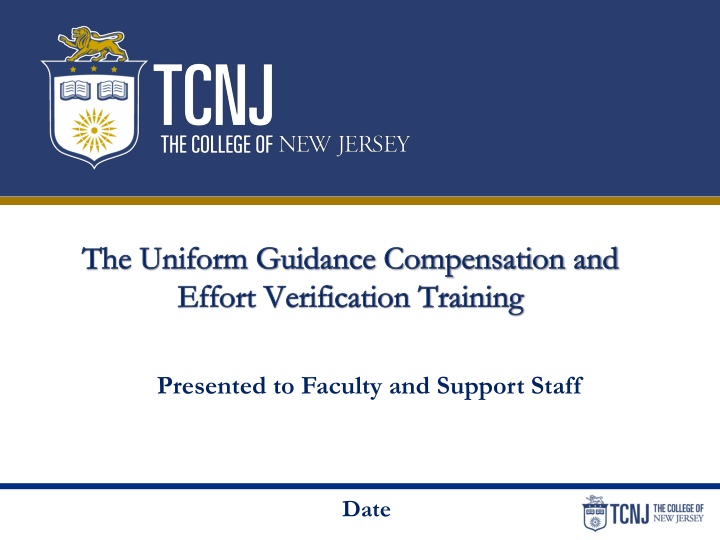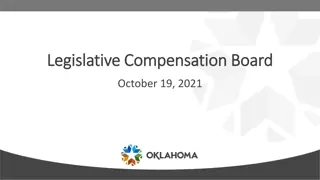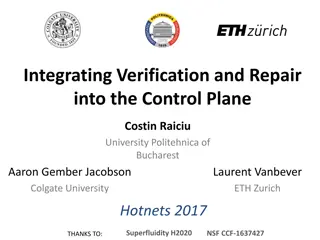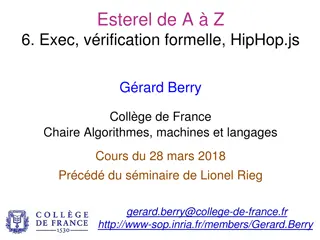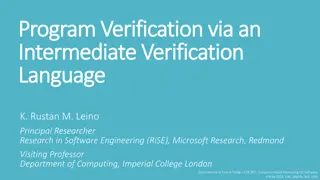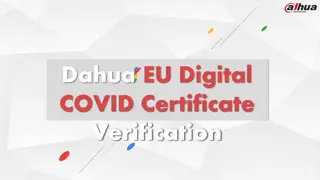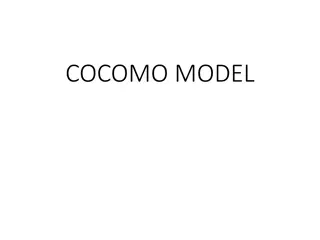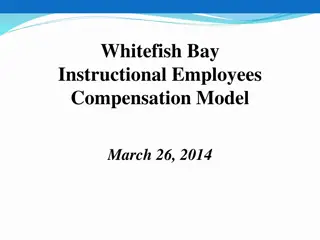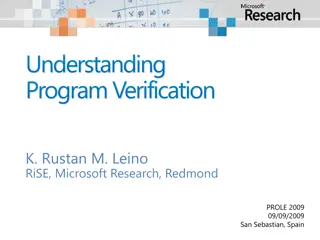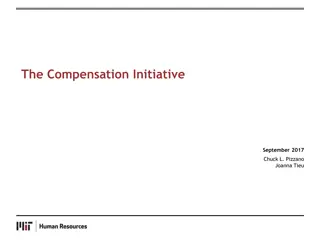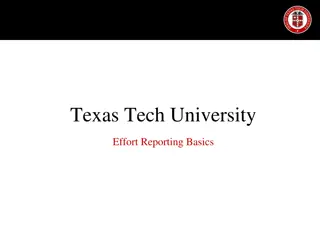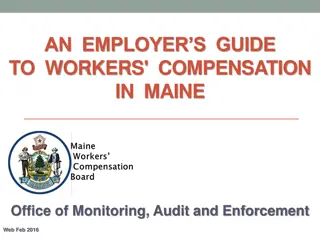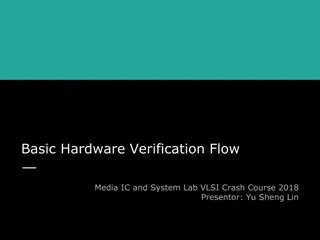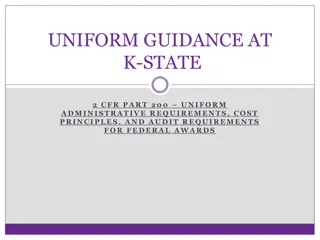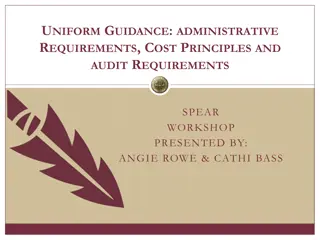Uniform Guidance Compensation and Effort Verification Training Overview
This content provides an overview of the Uniform Guidance, including changes, impact on existing awards, and key takeaways for faculty and support staff.
Download Presentation

Please find below an Image/Link to download the presentation.
The content on the website is provided AS IS for your information and personal use only. It may not be sold, licensed, or shared on other websites without obtaining consent from the author.If you encounter any issues during the download, it is possible that the publisher has removed the file from their server.
You are allowed to download the files provided on this website for personal or commercial use, subject to the condition that they are used lawfully. All files are the property of their respective owners.
The content on the website is provided AS IS for your information and personal use only. It may not be sold, licensed, or shared on other websites without obtaining consent from the author.
E N D
Presentation Transcript
The Uniform Guidance Compensation and Effort Verification Training Presented to Faculty and Support Staff Date 0
Agenda and Outcomes Agenda Introductions Background on the Uniform Guidance The Basic Idea Compensation Overview Effort Verification Processes Roles and Responsibilities Key Takeaways Resources Outcome: After this training we expect that you should have an understanding of the Uniform Guidance and the changes to the regulations for Compensation and Effort Verification, you should know your responsibilities, and know where to find answers to any questions that may arise. 1
1. Background on The Uniform Guidance 2
Background on Uniform Guidance OVERVIEW OF CHANGES The Uniform Guidance includes a combination of: Current Language from Existing Circulars Revised Language of Existing Circulars New Language The final guidance which went into effect December 26, 2014 superseded requirements from: OMB Circulars A-21, A-87, A-110, and A-122 (which have been placed in 2 C.F.R. Parts 220, 225, 215, and 230), Circulars A-89, A-102, and A-133 The guidance in Circular A-50 on Single Audit Act follow-up What Changed? What Remained the Same? Combined 8 Circulars into 1 Adjusted and revised the language and added new language Granted greater flexibility to the recipient Placed greater emphasis on institutional policies and internal controls In many respects the guidance remains unchanged However, just the change itself will result in increased scrutiny because of the renewed awareness and focus 3
Overview of Uniform Guidance & Institutional Impact EFFECTIVE DATES EXISTING AWARDS & GUIDANCE Existing Awards Pre-Existing Guidance Once the Uniform Guidance goes into effect for non-Federal entities, it will apply to Federal awards or funding increments after that date. It will not retroactively change the terms and conditions. Entities will likely make changes to their own policies and procedures that will impact their existing/older awards. Non-Federal entities wishing to implement entity-wide system changes to comply with the Uniform Guidance after the effective date of December 26, 2014 will not be penalized for doing so. TCNJ has adopted policies and procedures that impact existing awards. The terms and conditions for Federal awards (i.e. 2 CFR 220, 225, and 230) always govern. The Uniform Guidance is now in effect, Federal agencies need to ensure the continued availability of access to the terms and conditions of Federal awards made prior to the Uniform Guidance becoming effective. 4
Overview of Uniform Guidance & Institutional Impact COST PRINCIPLES - TIME & EFFORT (T&E) As long as institutions comply with general principles of T&E, they can apply unique practices of maintenance, which will lessen the administrative burden. FINAL OMB UNIFORM GUIDANCE Non-Federal entities are required to maintain high standards for internal controls over salaries and wages but are provided additional flexibility on how to implement processes to meet those standards. INSTITUTIONAL IMPACTAND IMPLICATIONS The general principles of time and effort still apply, but all institution types have the ability to implement independent practices for verifying payroll as long as they follow the Federal guidelines. Reporting requirements are consolidated across entities and specific methodologies for IHEs are eliminated. The complex language and example methods have been eliminated. Different allowable and unallowable compensation activities are defined and include special considerations for different types of non- Federal entities. 5
2. Compensation 6
Compensation UNIFORM GUIDANCE IMPACT The Uniform Guidance introduces a few new reforms and concepts... How these will translate to the audit landscape has yet to be seen. Maintains Past Guidance Clarifies Common Practices Provides Flexibility Salary follows an appointment Salary must accurately reflect the work performed Cost sharing or matching must be supported in the same manner as direct charges Reasonable applies Guidance for non- institutional activities is clarified Definition of institutional base salary is clarified Extra service payments and other appointment issues are clarified Non-exempt personnel records must capture hours worked each day Documentation specifics removed! Certification and First hand knowledge references removed Effort reporting frequency is not prescribed 7
Compensation PAYROLL DISTRIBUTION AND INSTITUTIONAL BASE SALARY (IBS) Institutional Base Salary Background Institutional Implications Defined as the annual compensation paid by an applicant/grantee organization for an employee's appointment, whether that individual's time is spent on research, teaching, patient care, or other activities. The base salary excludes any income that an individual is permitted to earn outside of duties for the applicant/grantee organization. IBS should include the base salary for the grantee organization only, unless the organization meets requirements to include practice plan salary in addition to standard salary. IBS should not change as the number of grants a PI/PD has increases or decreases. Institutions are not permitted to make salary adjustments solely based on sponsored funding. Uniform Guidance Clarification for Non-Profit Organizations: Compensation must be reasonable for the actual services rendered rather than a distribution of earnings in excess of costs. Compensation may include director's and executive committee member's fees, incentive awards, allowances for off-site pay, incentive pay, location allowances, hardship pay, and cost-of-living differentials. 8
Compensation PAYROLL DISTRIBUTION AND INSTITUTIONAL BASE SALARY Appointment letters are often used to define the activities that will comprise a full appointment 50% clinical 20% research 30% service Expectation for appointment Institutional base salary provides the monetary basis for allocating salary across all activities included in the full appointment $ Basis for compensating appointment Salary charged to sponsored programs is based on a percentage allocation of total activities for an individual relevant to an appointment Allocation by estimated portion of appointment Effort reports are used to verify the estimated distribution for the period of activity against actual activity Verifying estimated distribution against actual activity 9
3. Effort Verification 10
Effort Verification INTRODUCTION TO EFFORT Effort is the proportion of time spent on any activity and expressed as a percentage of the total professional activity for which an individual is employed by the institution. Be a reasonable estimate of time spent on activities The Basic Idea Total effort must equal 100% Effort is not based on a 35 hour week Throughout the project, we dedicate effort and charge salaryto the sponsor At award time, we make a commitment of effort In a grant proposal, we offer effort Periodically, sponsors want to know: Have we devoted enough effort to justify the salary charges? Even in cases where we are not charging salary to the sponsor, have we fulfilled our commitments? 11
Effort Verification UNIFORM GUIDANCE IMPACT EFFORT VERIFICATION Language from A-87, A-21 and A-122 are consolidated, merged and clarified into a single set of guidelines. 200.430 (Compensation Personal Services) and 200.303 (Internal Controls) are most relevant to Effort Reporting. Why the quotes ? No specific requirements for activity reports or personnel action forms No specific rules regarding effort reporting frequency No guidance on who may document/certify compensation costs Appropriate internal controls to verify that payroll is properly allocated and charged are required Estimates with a degree of tolerance are appropriate 12 12
Effort Verification UNIFORM GUIDANCE IMPACT EFFORT VERIFICATION Charges to sponsored projects must be based on records that accurately reflect the work performed. In addition, the records must: Be supported by a system of internal controls that provides reasonable assurance about the accuracy, allowability, and proper allocation of the charges Be incorporated into the entity s official records Reasonably reflect the total activity for which the employee is compensated by the entity, not exceeding 100% of compensated activities, or Institutional Base Salary Encompass both sponsored projects assisted and all other activities compensated by the institution on an integrated basis, i.e. reflect 100% of the employee s activities Comply with the entity s established accounting policies and practices Support the distribution of the employee s salary and wages among specific activities or cost objectives if the employee works on multiple activities 13 13
Effort Verification EFFORT VERIFICATION (THE STANDING CONCEPTS) Effort reporting is the ONLY method auditors can use to verify labor expense charged or cost-shared to sponsored programs Labor expenses represent ~2/3 of direct research costs on average for federal awards and over 50% of direct sponsored project costs at TCNJ Salary expense often the first area reviewed by auditors Most audits end up encompassing a review of effort reports Definitions Policies Procedures Forms Data Systems Proper Effort Reporting encompasses: Total percentages of payroll distributions serve as a starting point, since it is often assumed that payroll distribution is monitored and revised based on effort expended. But how does payroll distribution inform effort verification? 14
Effort Verification EFFORT CERTIFICATION IN THE AWARD LIFE CYCLE Effort reporting is the means of assuring sponsors that: Salary charges are justified PIs devoted the effort that was promised in the proposal and agreed upon at the time of the award Effort reports completed, approved, returned to central administration Effort reports filed Salary costs charged based on award budget End of specified time period reached Reports generated, sent out to units Adjustments made, if necessary 15
4. Processes 16
Processes COMPENSATION 1. Human Resources provides TCNJ faculty member with appointment letter listing his/her institutional base salary amount and assigned workload. 2. The New Jersey OMB Employee Benefit Reimbursement Rates circular establishes the annual fringe benefits rate for all TCNJ employees. 3. The appropriate academic administrator approves academic year release time for Principal Investigators, in accordance with the TCNJ Faculty Handbook, Faculty on Administrative Assignment. If release time is being requested during a semester when the faculty member is also working on sponsored projects, the request must be routed through OAGSR for additional approval. 4. All overload for faculty is voluntary in accordance with the TCNJ Faculty Handbook, Overload. If overload is being requested during a semester when the faculty member is also working on sponsored projects, the request must be routed through OAGSR for additional review and approval. 17
Processes COMPENSATION 5. The department and the Office of Human Resources establish the initial Labor Distribution for the faculty member in PeopleSoft appropriately. The faculty member should coordinate with any local administrative support staff to update the Labor Distribution accordingly if there is a significant change in effort. 6. Requests for any supplemental work beyond faculty standard workload must be approved by the Office of Human Resources, the appropriate Cabinet member, and the Office of the Treasurer, and be charged appropriately through the standard payroll system. 7. PI completes the Supplemental Payroll Authorization Form for summer salary and submits it to the Office of the Treasurer for approval and payment authorization. 8. PI completes effort verification forms as required by the Effort Verification Operating Policy to ensure the actual allocation of salary and fringe benefit expenses reflect actual effort. (see following slides) 18
Processes EFFORT VERIFICATION IN THE AWARD LIFE CYCLE Effort reporting plays a role in many of the major phases of the sponsored award life cycle. Verify available effort/document other supportDean Approve proposed cost shares Proposal Development and Submission Establish cost share accounts Assign the distribution Award Setup Effort Adjustments Require prior approvals Distribute effort reports Collect effort reports Verify completeness Effort Reporting Transfer costs for completed effort reports with changes Make timely cost allocations during the effort reporting period Make institutional base salary adjustments (if not established through distribution) Cost Allocations Change labor distributions Manage adjustments for no cost extensions Account Management Verify effort reports completed Verify cost sharing requirements were met Archive effort reports Closeouts 19
Processes EFFORT VERIFICATION 1. PI proposes effort on sponsored project applications, as requested salary, consistent with the estimated effort to be dedicated to the project. PI: Catelyn Stark ID: 999 Title: Night s Watch grant Sponsor: George R.R. Martin Foundation Catelyn Stark Catelyn Stark Jon Snow 20
Processes EFFORT VERIFICATION 2. PI requests that labor distributions be established to reflect estimated sponsored project effort for non-faculty employees using the Authorization for Employment Form. 21
Processes EFFORT VERIFICATION 3. PI monitors effort commitments across all sponsored and non-sponsored activities and coordinates with OAGSR to request a reduction in effort, as necessary. 4. The Office of the Treasurer generates and distributes Effort Verification Forms (EVFs) to the PIs/departments within 30 days after the end of the certification period (July 1 December 31 or January 1 June 30). 22
Processes EFFORT VERIFICATION 5. Employees complete their EVFs, indicating actual effort based on the time spent on various activities during the reporting period and sign the Forms. (Staff example below) 23
Processes EFFORT VERIFICATION 5. Employees complete their EVFs, indicating actual effort based on the time spent on various activities during the reporting period and sign the Forms. (Faculty example below) 24
Processes EFFORT VERIFICATION 6. Principal Investigators or relevant supervisors review, make adjustments as needed, and sign the EVFs for their staff based on their assessment of actual time spent on various activities during the reporting period. 7. PIs/departments return completed EVFs to the Office of the Treasurer within 30 days of their distribution. 8. The Office of the Treasurer reviews completed EVFs, identifies when labor cost transfers are required, and processes all associated required transactions. 9. If completed EVFs are not received within the 30-day timeframe, the matter is escalated, accordingly, by the Office of the Treasurer. 10. If cost transfers are submitted that affect previously verified effort, the Office of the Treasurer identifies these transfers, obtains the necessary justifications and supporting documents, escalates the review accordingly, and processes all necessary adjustments. 25
5. Roles and Responsibilities 26
Roles and Responsibilities PRINCIPAL INVESTIGATOR IS RESPONSIBLE FOR: Ensuring proposal budgets, including cost share budgets, include accurate requests for the portion of IBS, summer salary, and fringe benefits corresponding to proposed effort and that all such expenditures conform to sponsor and award requirements. Submitting internal requests and obtaining approval for reassigned time, overload, summer salary and supplemental pay, when necessary. Providing reasonable estimates of effort in order to carry out the aims of the proposals and fulfill other College obligations. Meeting commitments to sponsor regarding effort and cost sharing and complying with sponsor requirements regarding reduction in effort. Requesting that labor distributions be set up consistent with effort estimates, and submitting revised Authorization for Employment Forms when there are changes to estimated effort or the projects to which labor distributions should be charged. Being fully aware of their own level of effort, as well as their staff members levels of effort, committed, charged, and reported on all sponsored projects. Verifying their own individual effort and reviewing the EVFs of their staff members. Returning completed EVFs to the Office of the Treasurer within 30 days of distribution. Communicating significant effort changes to the project administrative support staff, the Office of the Treasurer, and the sponsor. 10. Verifying revised EVFs and providing justification and supporting documentation if effort changes are made following prior verification. 1. 2. 3. 4. 5. 6. 7. 8. 9. 27
Roles and Responsibilities PROJECT ADMINISTRATIVE SUPPORT STAFF ARE RESPONSIBLE FOR: 1. Assisting PI with ensuring proposal budgets, including cost share budgets, include accurate requests for the portion of IBS, summer salary, and fringe benefits corresponding to proposed effort. 2. Assisting PI with submitting internal requests and obtaining approval for reassigned time, overload, summer salary, and supplemental pay, when necessary. 3. Assisting PIs in providing reasonable estimates of effort in order to carry out the aims of the proposals and fulfill other College obligations. 4. Assisting PIs with monitoring effort commitments, salary charges, and cost sharing on all applicable awards. 5. Assisting PIs with requesting that labor distributions be established consistent with effort estimates. 6. Assisting PIs with returning completed EVFs to the Office of the Treasurer within 30 days of distribution. 28
Roles and Responsibilities DEPARTMENT CHAIR/DEANS ARE RESPONSIBLE FOR: 1. Reviewing and approving PI requests for overload, summer salary, and supplemental pay. 2. Reviewing and signing PI EVFs. 3. Reviewing and approving justifications for modifications to previously verified effort. OFFICE OF ACADEMIC GRANTS AND SPONSORED RESEARCH (OAGSR) 1. Reviewing proposal budgets, including cost share budgets, to verify that they include accurate requests for IBS, summer salary, and fringe benefits and are in compliance with sponsor/award requirements and institutional policy. 2. Reviewing requests for award-funded reassigned time, overload, summer salary, and supplemental pay requests to verify the requests are compliant with sponsor/award requirements. 3. Ensuring that proposed effort and salary requests submitted to sponsors are reviewed in accordance with the requirements of this policy and of the sponsor. 4. Reviewing and facilitating requests, as necessary, for adjustments of effort as required by sponsor terms and conditions. 29
Roles and Responsibilities HUMAN RESOURCES IS RESPONSIBLE FOR: 1. Processing Authorization for Employment Forms accurately and timely to ensure labor distributions are consistent with the allocations on the AFE Form. OFFICE OF THE TREASURER IS RESPONSIBLE FOR: 1. Updating Labor Distributions in PeopleSoft for faculty and staff in accordance with estimated effort on sponsored projects. 2. Authorizing payment of summer salary and supplemental pay. 3. Reviewing and approving Authorization for Employment Forms. 4. Generating and distributing EVFs to PIs/departments. 5. Ensuring that completed EVFs are collected within 30 days of distribution and, if not collected, escalating the matter in accordance with this policy. 6. Contacting Departments/Principal Investigators that have outstanding EVFs. 7. Identifying the need for cost transfers resulting from verified effort, and processing the cost transfers according to standard process. 8. Reviewing and approving justifications for modifications to previously verified effort. 30
6. Practice Activities 31
Practice Activity ACTIVITY It is July 16, 2016 and a new award for has come through for John Doe from FIFA (Federal Institute for Football Antics). He had committed 25% annual effort on this grant, and 20% was to be charged to the grant. The start date is August 1. What is the most compliant method of setting up salary charges for John Doe on the award? (A) Wait until the end of the quarter to see what he actually did and then retroactively charge the grant through a journal entry form. (B) Process the salary distribution right away to charge 20% of his salary to the grant starting August 1st. No need to talk with him get it done! (C) Complete an Authorization for Employment Form to charge 20% of John s salary to the grant. (D) Complete an Authorization for Employment Form to charge 20% of John s salary to the grant and 5% to a cost sharing account. 32
Practice Activity ACTIVITY Which of these would likely be considered unacceptable practices in the event of an audit? (A) Effort reports signed by a local administrator in departments with 25 key personnel and 100 employees working on 50 different sponsored awards (B) Differing bases of salary for applying effort (C) Effort reports that include all sources of pay that are associated with an individual s total institutional effort as defined by the institution (D) Effort reporting is done each quarter, at the start of the quarter 33 33
7. Key Takeaways 34
Effort Verification EFFORT VERIFICATION (THE STANDING TAKEAWAYS) Effort is managed in each phase of the award life cycle. Be aware of final commitments at award time. Begin charging (or cost-sharing) salary at project start - % of salary charged The rules require us to: should reasonably reflect work performed Effort verification is the means of assuring sponsors that salary charges are justified and investigators devoted the effort they promised in the proposal. Auditors use effort reporting as a means to verify labor expense charged or cost-shared Fulfill commitments, or change commitments when needed, and document the changes 100% effort is the total professional effort performed for institutional base salary, not x hours/ week. Verify payroll was charged consistently with what actually happened 35
8. Resources 36
Resources ADDITIONAL GUIDANCE: COURSE BUYOUT/REASSIGNED TIME UNIT POLICY Faculty are required to teach a minimum of 1 course per semester. A full course load is considered 3 course with a fourth period offered for research and scholarship. A normal faculty academic course load might look like the following; Fall Semester Spring Semester Course A Course A Course B Course B Course C Course C Research/Scholarship Research/Scholarship A schedule with an approved SOSA and buyout might look like the following: Usually, reassigned time, paid with grant dollars, are incorporated into the Research/Scholarship slot. Course A Course A Course B Course B SOSA Course Buyout Research/Scholarship (or Reassigned) Research/Scholarship (or Reassigned) Faculty are discouraged from using SOSA and course buyout the same semester and reassigned time with overload time as it can be applicative. With a typical course load, one course buyout or research/scholarship slot equates to 12.5% of salary. 37
Resources WHERE TO GET HELP 1. Reference updated policies and procedures on the OAGSR website (http://academicgrants.tcnj.edu/) 2. Sign up for additional trainings 3. Review the relevant HR websites Benefits - http://hr.tcnj.edu/benefits/benefits-summary/ Union Contracts - http://hr.tcnj.edu/recruitment-faculty-staff/employment/employee- relations-faculty/ Labor Laws and Regulations - http://hr.tcnj.edu/compliance/ 4. Review the Uniform Guidance Language (http://www.ecfr.gov/cgi-bin/text- idx?tpl=/ecfrbrowse/Title02/2cfr200_main_02.tpl ) 5. Ask your colleagues 6. Contact OAGSR Green Hall, Room 202 P) 609.771.3255 E) grants@tcnj.edu 7. Contact the Office of the Treasurer Green Hall, Room 207 P) 609.771.2186 W) http://finance.tcnj.edu/ 38
9. Appendix 39
Introduction to the Uniform Guidance ORGANIZATION - SUBPARTS Subpart A Acronyms and Definitions Subpart B General Provisions Subpart C Pre-Federal Award Requirements and Contents of Federal Awards Subpart D Post Federal Award Requirements Subpart E Cost Principles Subpart F Audit Requirements 40
Introduction to the Uniform Guidance ORGANIZATION - APPENDIX TO PART 200 Appendix I Full Text of Notice of Funding Opportunity Appendix II Contract Provisions for Non-Federal Entity Contracts Under Federal Awards Indirect (F&A) Costs Identification and Assignment, and Rate Determination for Institutions of Higher Education (IHEs) Indirect (F&A) Costs Identification and Assignment, and Rate Determination for Nonprofit Organizations Appendix III Appendix IV Appendix V State/Local Government and Indian Tribe-Wide Central Service Cost Allocation (Transfer) Plans Appendix VI Public Assistance Cost Allocation (Transfer) Plans Appendix VII States and Local Government and Indian Tribe Indirect Cost Proposals Appendix VIII Nonprofit Organizations Exempted From Subpart E Cost Principles of Part 200 Appendix IX Hospital Cost Principles Appendix X Data Collection Form (Form SF SAC) Appendix XI Compliance Supplement 41
Overview of Uniform Guidance & Institutional Impact COST PRINCIPLES - DIRECT COSTS Guidelines promote the clarification as well as standardization of the direct cost allowability across institutions. FINAL OMB UNIFORM GUIDANCE Further clarifications made in allocability and allowability of certain direct costs. INSTITUTIONAL IMPACTAND IMPLICATIONS A single common cost principles circular creates common accounting standards for all grant recipients, regardless of institutional type. 42
Overview of Uniform Guidance & Institutional Impact COST PRINCIPLES - ADMINISTRATIVE SUPPORT Institutions can charge directly allocable administrative support as a direct cost. FINAL OMB UNIFORM GUIDANCE In order for clerical costs to be allowable as a direct charge, the Federal awarding agency s prior approval is required. INSTITUTIONAL IMPACTAND IMPLICATIONS Institutions may charge administrative and clerical salaries, as well as other items of cost, directly to a Federal award when it is appropriate, allocable and meets the conditions outlined in the Federal guidance. Additional language was added to allow for this approval after the initial budget approval in order to allow for flexibility in implementation. The burden for justifying direct costs as allocable to an award remains with the institution. 43
Overview of Uniform Guidance & Institutional Impact COST PRINCIPLES - COMPUTING DEVICES This change includes the cost of certain computing devices as allowable direct cost supplies. FINAL OMB UNIFORM GUIDANCE Computing devices are subject to the less burdensome administrative requirements of supplies (as opposed to equipment). INSTITUTIONAL IMPACTAND IMPLICATIONS Computing devices not considered a depreciable asset by an institution s capitalization policy may be charged and treated as supplies. The acquisition cost must be less than the lesser of the capitalization level established by the non- Federal entity for financial statement purposes or $5,000, regardless of the length of its useful life. The burden of obtaining prior approval for such purchases is reduced. However, institutions must follow the same practices for determining and documenting allocability (direct versus indirect use) when charging computing devices to sponsored awards. 44
Overview of Uniform Guidance & Institutional Impact POST-AWARD REQUIREMENTS - COST SHARING Establishes positive cost sharing policy, which limits when cost sharing can be required as well as eliminates cost share as a factor during the review of an application. FINAL OMB UNIFORM GUIDANCE Cost sharing can only be required when clearly defined in the funding opportunity notice. INSTITUTIONAL IMPACTAND IMPLICATIONS Federally required institutional cost share will be limited. Voluntary committed cost sharing should not be used as a factor in the review of applications. Institutions will have additional regulations-based support to discourage voluntary cost share commitments. Voluntary committed cost sharing is prohibited for Federal project proposals except where otherwise required by statute. 45
Overview of Uniform Guidance & Institutional Impact POST-AWARD REQUIREMENTS - SUBCONTRACT MONITORING The prime awardee sets requirements and leads subcontract monitoring. FINAL OMB UNIFORM GUIDANCE Subrecipient monitoring tools currently in the Compliance Supplement are integrated. INSTITUTIONAL IMPACTAND IMPLICATIONS 10% MTDC minimum rate facilitates collaboration with subrecipients. Pass-through entities must honor either a negotiated or minimum 10% of MTDC indirect cost rate for sub-recipients. Prime awardee institutions decide what is necessary for monitoring subrecipients, including the review of financial and programmatic reports, in order to meet their own obligations under Federal awards. Subrecipient monitoring via the review of performance and financial reports is limited to what the pass-through entity has deemed necessary to meet their own requirements under the Federal award. Only when findings pertain to federal funds provided to sub-recipients, must the pass- through entity manage corrective actions. Only when findings pertain to Federal award funds provided to the subrecipient by the pass- through entity does the pass-through entity have to follow up, ensure corrective action, and issue management decisions on weaknesses. 46
Overview of Uniform Guidance & Institutional Impact POST-AWARD REQUIREMENTS SUBCONTRACT / VENDOR CLARIFICATION Provides clarification between subrecipient and vendors and assigns responsibility for determination to mitigate disagreements with sponsor classification. FINAL OMB UNIFORM GUIDANCE The agreement characteristics necessary to determine subrecipients vs. vendors on Federal awards are clarified. INSTITUTIONAL IMPACTAND IMPLICATIONS Clarification should help mitigate agency retrospective disagreement of determination. Responsibility for making this determination is assigned to the pass-through entity. 47
Overview of Uniform Guidance & Institutional Impact COST PRINCIPLES - PROCUREMENT Institutions will have additional procurement standards such as required competition and equipment screening requirements. FINAL OMB UNIFORM GUIDANCE A bearclaw of procurement method requirements is outlined. INSTITUTIONAL IMPACTAND IMPLICATIONS The cost or price analysis threshold, set in accordance with the simplified acquisition threshold, will streamline institutional procurement processes. The threshold for small purchase procedures is raised to $150,000 to be consistent with the simplified acquisition threshold in the Federal Acquisition Regulation (FAR). However, other actions will require additional administration in procurement areas, such as inter-entity agreements for shared services. Non-Federal entities are required to avoid duplicative purchases and encouraged to enter into agreements for shared goods and services. Institutional P-Card policies, especially for purchases over $3,000 may be in conflict with Federal requirements. All A-110 language on procurement is replaced by A-102 section .36. Minor clarification to language requires non- Federal entities to maintain oversight rather than a system that ensures contractor performance. 48
